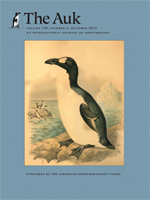Many waterbirds reproduce seasonally in response to fluctuations in food supply. White-shouldered Ibises (Pseudibis davisoni) breed during the dry, water-drawdown season, but, unlike other waterbirds, they do not take advantage of prey concentrated in diminishing pools. To understand how this species successfully feeds and breeds at the driest time of year, we studied its habitat use and diet, and the habitat conditions that influence intake rates and prey density at waterholes. Foraging observations, prey sampling, and landscape-scale assessment of habitat availability were undertaken (at 7, 47, and 58 waterholes, respectively) over two breeding seasons. Although they rarely foraged in water, the birds used all exposed substrates, feeding on amphibians and small invertebrates. Amphibians were the most abundant prey in waterhole substrates and accounted for 81% of overall biomass intake. Both intake rates and density of amphibian prey biomass were greater in dry than in moist or saturated substrates. Intake rates and density of prey biomass changed little through the dry season, but exposed substrate extent increased by 74%. The White-shouldered Ibis's use of dry waterhole substrates to exploit seasonally concentrated prey is unusual among large waterbirds, and we suggest that its breeding season may be timed to coincide with receding water levels and increasing substrate exposure. Estimated prey requirements of a breeding pair over the nesting period were equivalent to nearly two-thirds of amphibian biomass found at large waterholes. Each pair may therefore require multiple waterholes to overcome prey depletion and breed successfully, which is consistent with the noncolonial dispersed distribution of nesting pairs.
How to translate text using browser tools
1 October 2013
Amphibian Concentrations in Desiccating Mud May Determine the Breeding Season of the White-Shouldered Ibis ( Pseudibis davisoni)
Hugh L. Wright,
Nigel J. Collar,
Iain R. Lake,
Paul M. Dolman
ACCESS THE FULL ARTICLE

The Auk
Vol. 130 • No. 4
October 2013
Vol. 130 • No. 4
October 2013
Cambodia
foraging
intake rate
nesting time
prey density
prey depletion
Pseudibis davisoni




